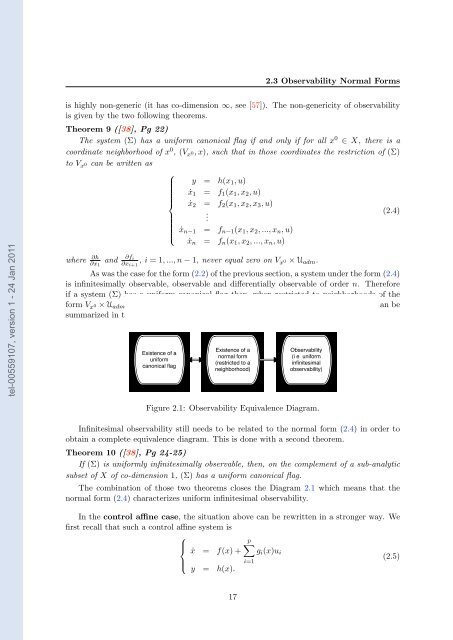Adaptative high-gain extended Kalman filter and applications
Adaptative high-gain extended Kalman filter and applications
Adaptative high-gain extended Kalman filter and applications
Create successful ePaper yourself
Turn your PDF publications into a flip-book with our unique Google optimized e-Paper software.
tel-00559107, version 1 - 24 Jan 2011<br />
2.3 Observability Normal Forms<br />
is <strong>high</strong>ly non-generic (it has co-dimension ∞, see [57]). The non-genericity of observability<br />
is given by the two following theorems.<br />
Theorem 9 ([38], Pg 22)<br />
The system (Σ) has a uniform canonical flag if <strong>and</strong> only if for all x 0 ∈ X, there is a<br />
coordinate neighborhood of x 0 , (V x 0,x), such that in those coordinates the restriction of (Σ)<br />
to V x 0 can be written as<br />
where ∂h<br />
∂x1<br />
⎧<br />
⎪⎨<br />
⎪⎩<br />
y = h(x1,u)<br />
˙x1 = f1(x1,x2,u)<br />
˙x2 = f2(x1,x2,x3,u)<br />
.<br />
˙xn−1 = fn−1(x1,x2, ..., xn,u)<br />
˙xn = fn(x1,x2, ..., xn,u)<br />
∂fi <strong>and</strong> ∂xi+1 , i =1, ..., n − 1, never equal zero on Vx0 × Uadm.<br />
(2.4)<br />
As was the case for the form (2.2) of the previous section, a system under the form (2.4)<br />
is infinitesimally observable, observable <strong>and</strong> differentially observable of order n. Therefore<br />
if a system (Σ) has a uniform canonical flag then when restricted to neighborhoods of the<br />
form Vx0 × Uadm<br />
an be<br />
summarized in t<br />
Existence of a<br />
uniform<br />
canonical flag<br />
Existence of a<br />
normal form<br />
(restricted to a<br />
neighborhood)<br />
Observability<br />
(i e uniform<br />
infinitesimal<br />
observability)<br />
Figure 2.1: Observability Equivalence Diagram.<br />
Infinitesimal observability still needs to be related to the normal form (2.4) in order to<br />
obtain a complete equivalence diagram. This is done with a second theorem.<br />
Theorem 10 ([38], Pg 24-25)<br />
If (Σ) is uniformly infinitesimally observable, then, on the complement of a sub-analytic<br />
subset of X of co-dimension 1, (Σ) has a uniform canonical flag.<br />
The combination of those two theorems closes the Diagram 2.1 which means that the<br />
normal form (2.4) characterizes uniform infinitesimal observability.<br />
In the control affine case, the situation above can be rewritten in a stronger way. We<br />
first recall that such a control affine system is<br />
⎧<br />
p�<br />
⎪⎨<br />
˙x = f(x)+ gi(x)ui<br />
(2.5)<br />
⎪⎩<br />
i=1<br />
y = h(x).<br />
17

















